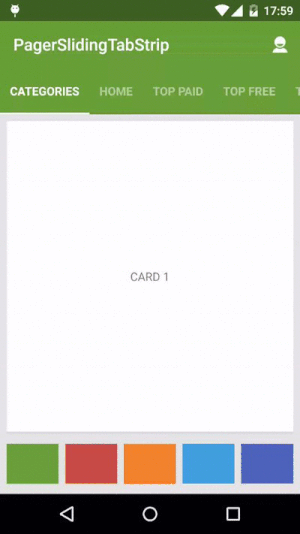剖析项目名称: Android PagerSlidingTabStrip (default Material Design)
剖析原项目地址:https://codeload.github.com/jpardogo/PagerSlidingTabStrip/zip/master
剖析理由:只知其然而不知其所以然,如此不好。想要快速的进阶,不走寻常路,剖析开源项目,深入理解扩展知识,仅仅这样还不够,还需要如此:左手爱哥的设计模式,右手重构改善既有设计,如此漫长打坐,回过头再看来时的路,书已成山,相信翔哥说的,量变引起质变。
话不多说,献上Gif(没有Gif就是耍流氓了O(∩_∩)O~)

Android studio 导入项目里面一键搞定(AS的魅力真的很大,我都把持不住啦)
compile 'com.jpardogo.materialtabstrip:library:1.1.0'
作为一个依赖导入到自己项目,xml布局调用实例:
<com.astuetz.PagerSlidingTabStrip android:id="@+id/tabs" android:layout_width="match_parent" android:layout_height="?attr/actionBarSize" android:background="?attr/colorPrimary" />
PagerSlidingTabStrip配合ViewPager一起使用,当ViewPager的onPagerChangeListener回调时,PagerSlidingTabStrip也一起随之变动,具体做法都已封装到了PagerSlidingTabStrip.setViewPager()方法里,使用时调用实例如下:
// Initialize the ViewPager and set an adapter ViewPager pager = (ViewPager) findViewById(R.id.pager) pager.setAdapter(new TestAdapter(getSupportFragmentManager())) // Bind the tabs to the ViewPager PagerSlidingTabStrip tabs = (PagerSlidingTabStrip) findViewById(R.id.tabs) tabs.setViewPager(pager)
如果你需要监听PagerSlidingTabStrip的check状态变化,只需要如此:
tabs.setOnPageChangeListener(mPageChangeListener);
下面是一些关于自定义属性的简短说明,如果你需要定制化的UI可以通过引用这些属性帮助你实现你想要的效果。
- android:textColorPrimary 文字颜色
- pstsIndicatorColor 滑动指示器颜色
- pstsIndicatorHeight 滑动指示器高度
- pstsUnderlineColor 视图的底部的全宽线的颜色
- pstsUnderlineHeight 视图的底部的全宽线的高度
- pstsDividerColor 选项卡之间的分隔线的颜色
- pstsDividerWidth 选项卡之间的分隔线的宽度
- pstsDividerPadding 选项卡之间的分隔线的Pading填充
- pstsShouldExpand 如果设置为true,每个选项卡都是相同的weight,即LinearLayout的权重一样,默认为false
- pstsScrollOffset 滑动Tab的偏移量
- pstsPaddingMiddle 如果true,视图的标签会以居中显示的方式呈现。
- pstsTabPaddingLeftRight 每个标签左右填充宽度
- pstsTabBackground 每个标签的背景,应该是一个selector,checked=”true/false”对应不同的背景
- pstsTabTextSize Tab标签的文字大小
- pstsTabTextColor Tab标签的文字颜色
- pstsTabTextStyle
- pstsTabTextAllCaps 如果为true,所有标签都是大写字母,默认为true
- pstsTabTextAlpha 设置文本alpha透明度不选中的选项卡。0 . . 255之间,150是默认值。
- pstsTabTextFontFamily Tab标签文字的字体
- setTypeface(Typeface typeface, int style) 设置字体,把字体放入assets里通过该方法调用
先看看github上作者提供的compile:
dependencies { compile fileTree(dir: 'libs', include: ['*.jar']) testCompile 'junit:junit:4.12' compile "com.android.support:appcompat-v7:22.2.0" compile 'com.android.support:cardview-v7:22.2.0' compile 'com.jakewharton:butterknife:6.0.0' compile 'com.readystatesoftware.systembartint:systembartint:1.0.3' compile 'com.nineoldandroids:library:2.4.0' compile 'com.jpardogo.materialtabstrip:library:1.1.0'}
用了V7包,状态栏和标题栏的颜色修改需要,cardView稍后细说,butterknife第三方注解框架,我比较喜欢用xutils,用法都差不多,这里就不细说,不解就看官方文档说明,systembartint这个是一个关于沉浸式状态栏的兼容包,向下兼容到4.4,nineoldandroids动画库。这里简单的提一下,沉浸式状态栏,在不同的手机和系统上可能存在兼容性问题,这里以5.1系统的手机为实例,做个简单的demo
<style name="AppBaseTheme" parent="Theme.AppCompat.Light.NoActionBar"> <! <item name="android:windowBackground">@color/background_window</item> <! <! <item name="colorPrimary">@color/colorPrimary</item> <! <item name="colorPrimaryDark">@color/colorPrimaryDark</item> <! <item name="colorAccent">@color/colorAccent</item> <! <item name="android:textColorPrimary">@android:color/white</item> </style> <style name="AppTheme" parent="AppBaseTheme" />
Value-v19里面设置透明属性并在activity_main里面设置一个属性fitsSystemWindows(给状态栏预留空间,如果开发中遇到兼容问题建议这里通过style引用该属性):
<style name="AppTheme" parent="AppBaseTheme"> <item name="android:windowTranslucentStatus">true</item> </style> android:fitsSystemWindows="true"
Activity测试类调用systembartint设置沉浸式状态栏相关属性
public class MainActivity extends ActionBarActivity { private SystemBarTintManager mTintManager; @Override protected void onCreate(Bundle savedInstanceState) { super.onCreate(savedInstanceState); setContentView(R.layout.activity_main); mTintManager = new SystemBarTintManager(this); mTintManager.setStatusBarTintEnabled(true); mTintManager.setTintColor(getResources().getColor(R.color.colorPrimary)); }}
- 1
- 2
- 3
- 4
- 5
- 6
- 7
- 8
- 9
- 10
- 11
- 12
- 13
- 14
- 15
- 16
- 17
- 1
- 2
- 3
- 4
- 5
- 6
- 7
- 8
- 9
- 10
- 11
- 12
- 13
- 14
- 15
- 16
- 17

demo太简单了,就不上传资源了,作者github上demo底部动态控制沉浸式状态栏,通过onClick获取颜色值,调用changeColor重新赋值,在开发中结合抽屉控件可以达到意想不到的效果。不过这些都不是本文重点,还是回到主题PagerSlidingTabStrip.Java
public class PagerSlidingTabStrip extends HorizontalScrollView { public static final int DEF_VALUE_TAB_TEXT_ALPHA = 150; private int mTabBackgroundResId = R.drawable.psts_background_tab; public PagerSlidingTabStrip(Context context) { this(context, null); } public PagerSlidingTabStrip(Context context, AttributeSet attrs) { this(context, attrs, 0); } public PagerSlidingTabStrip(Context context, AttributeSet attrs, int defStyle) { super(context, attrs, defStyle); setFillViewport(true); setWillNotDraw(false); mTabsContainer = new LinearLayout(context); mTabsContainer.setOrientation(LinearLayout.HORIZONTAL); addView(mTabsContainer); mRectPaint = new Paint(); mRectPaint.setAntiAlias(true); mRectPaint.setStyle(Style.FILL); DisplayMetrics dm = getResources().getDisplayMetrics(); mScrollOffset = (int) TypedValue.applyDimension(TypedValue.COMPLEX_UNIT_DIP, mScrollOffset, dm); mDividerPaint = new Paint(); mDividerPaint.setAntiAlias(true); mDividerPaint.setStrokeWidth(mDividerWidth); TypedArray a = context.obtainStyledAttributes(attrs, ANDROID_ATTRS); int textPrimaryColor = a.getColor(TEXT_COLOR_PRIMARY, getResources().getColor(android.R.color.black)); mUnderlineColor = textPrimaryColor; mDividerColor = textPrimaryColor; mIndicatorColor = textPrimaryColor; int padding = a.getDimensionPixelSize(PADDING_INDEX, 0); mPaddingLeft = padding > 0 ? padding : a.getDimensionPixelSize(PADDING_LEFT_INDEX, 0); mPaddingRight = padding > 0 ? padding : a.getDimensionPixelSize(PADDING_RIGHT_INDEX, 0); a.recycle(); String tabTextTypefaceName = "sans-serif"; if (Build.VERSION.SDK_INT >= Build.VERSION_CODES.LOLLIPOP) { tabTextTypefaceName = "sans-serif-medium"; mTabTextTypefaceStyle = Typeface.NORMAL; } a = context.obtainStyledAttributes(attrs, R.styleable.PagerSlidingTabStrip); mIndicatorColor = a.getColor(R.styleable.PagerSlidingTabStrip_pstsIndicatorColor, mIndicatorColor); a.recycle(); if (mTabTextColor == null) { mTabTextColor = createColorStateList( textPrimaryColor, textPrimaryColor, Color.argb(tabTextAlpha, Color.red(textPrimaryColor), Color.green(textPrimaryColor), Color.blue(textPrimaryColor))); } if (fontFamily != null) { tabTextTypefaceName = fontFamily; } mTabTextTypeface = Typeface.create(tabTextTypefaceName, mTabTextTypefaceStyle); setTabsContainerParentViewPaddings(); mTabLayoutParams = isExpandTabs ? new LinearLayout.LayoutParams(0, LayoutParams.MATCH_PARENT, 1.0f) : new LinearLayout.LayoutParams(LayoutParams.WRAP_CONTENT, LayoutParams.MATCH_PARENT); }}
- 1
- 2
- 3
- 4
- 5
- 6
- 7
- 8
- 9
- 10
- 11
- 12
- 13
- 14
- 15
- 16
- 17
- 18
- 19
- 20
- 21
- 22
- 23
- 24
- 25
- 26
- 27
- 28
- 29
- 30
- 31
- 32
- 33
- 34
- 35
- 36
- 37
- 38
- 39
- 40
- 41
- 42
- 43
- 44
- 45
- 46
- 47
- 48
- 49
- 50
- 51
- 52
- 53
- 54
- 55
- 56
- 57
- 58
- 59
- 60
- 61
- 62
- 63
- 64
- 65
- 66
- 67
- 68
- 69
- 70
- 71
- 72
- 73
- 74
- 75
- 76
- 77
- 78
- 79
- 80
- 81
- 82
- 83
- 84
- 85
- 86
- 87
- 88
- 89
- 90
- 91
- 92
- 93
- 1
- 2
- 3
- 4
- 5
- 6
- 7
- 8
- 9
- 10
- 11
- 12
- 13
- 14
- 15
- 16
- 17
- 18
- 19
- 20
- 21
- 22
- 23
- 24
- 25
- 26
- 27
- 28
- 29
- 30
- 31
- 32
- 33
- 34
- 35
- 36
- 37
- 38
- 39
- 40
- 41
- 42
- 43
- 44
- 45
- 46
- 47
- 48
- 49
- 50
- 51
- 52
- 53
- 54
- 55
- 56
- 57
- 58
- 59
- 60
- 61
- 62
- 63
- 64
- 65
- 66
- 67
- 68
- 69
- 70
- 71
- 72
- 73
- 74
- 75
- 76
- 77
- 78
- 79
- 80
- 81
- 82
- 83
- 84
- 85
- 86
- 87
- 88
- 89
- 90
- 91
- 92
- 93
onAttachedToWindow方法给传入的ViewPager的Adapter注册观察者,onDetachedFromWindow则注销观察者,当Adapter数据发生变化时,通过观察者调用onChanged方法调用该类里定义的刷新方法,当数据集失效时,会调用DataSetObserver的onINvalidated()方法。
@Override protected void onAttachedToWindow() { super.onAttachedToWindow(); if (mPager != null) { if (!mAdapterObserver.isAttached()) { mPager.getAdapter().registerDataSetObserver(mAdapterObserver); mAdapterObserver.setAttached(true); } } } @Override protected void onDetachedFromWindow() { super.onDetachedFromWindow(); if (mPager != null) { if (mAdapterObserver.isAttached()) { mPager.getAdapter().unregisterDataSetObserver(mAdapterObserver); mAdapterObserver.setAttached(false); } } }
- 1
- 2
- 3
- 4
- 5
- 6
- 7
- 8
- 9
- 10
- 11
- 12
- 13
- 14
- 15
- 16
- 17
- 18
- 19
- 20
- 21
- 1
- 2
- 3
- 4
- 5
- 6
- 7
- 8
- 9
- 10
- 11
- 12
- 13
- 14
- 15
- 16
- 17
- 18
- 19
- 20
- 21
View视图的测量,onLayout重新计算width,并添加OnGlobalLayoutListener
@Override protected void onLayout(boolean changed, int l, int t, int r, int b) { if (isPaddingMiddle || mPaddingLeft > 0 || mPaddingRight > 0) { int width; if (isPaddingMiddle) { width = getWidth(); } else { width = getWidth() - mPaddingLeft - mPaddingRight; } mTabsContainer.setMinimumWidth(width); setClipToPadding(false); } if (mTabsContainer.getChildCount() > 0) { mTabsContainer .getChildAt(0) .getViewTreeObserver() .addOnGlobalLayoutListener(firstTabGlobalLayoutListener); } super.onLayout(changed, l, t, r, b); }
- 1
- 2
- 3
- 4
- 5
- 6
- 7
- 8
- 9
- 10
- 11
- 12
- 13
- 14
- 15
- 16
- 17
- 18
- 19
- 20
- 21
- 22
- 23
- 24
- 25
- 26
- 27
- 28
- 1
- 2
- 3
- 4
- 5
- 6
- 7
- 8
- 9
- 10
- 11
- 12
- 13
- 14
- 15
- 16
- 17
- 18
- 19
- 20
- 21
- 22
- 23
- 24
- 25
- 26
- 27
- 28
再来看看大功臣onDraw方法
@Override protected void onDraw(Canvas canvas) { super.onDraw(canvas); if (isInEditMode() || mTabCount == 0) { return; } final int height = getHeight(); if (mDividerWidth > 0) { mDividerPaint.setStrokeWidth(mDividerWidth); mDividerPaint.setColor(mDividerColor); for (int i = 0; i < mTabCount - 1; i++) { View tab = mTabsContainer.getChildAt(i); canvas.drawLine(tab.getRight(), mDividerPadding, tab.getRight(), height - mDividerPadding, mDividerPaint); } } if (mUnderlineHeight > 0) { mRectPaint.setColor(mUnderlineColor); canvas.drawRect(mPaddingLeft, height - mUnderlineHeight, mTabsContainer.getWidth() + mPaddingRight, height, mRectPaint); } if (mIndicatorHeight > 0) { mRectPaint.setColor(mIndicatorColor); Pair<Float, Float> lines = getIndicatorCoordinates(); canvas.drawRect(lines.first + mPaddingLeft, height - mIndicatorHeight, lines.second + mPaddingLeft, height, mRectPaint); } }
- 1
- 2
- 3
- 4
- 5
- 6
- 7
- 8
- 9
- 10
- 11
- 12
- 13
- 14
- 15
- 16
- 17
- 18
- 19
- 20
- 21
- 22
- 23
- 24
- 25
- 26
- 27
- 28
- 29
- 30
- 31
- 32
- 33
- 34
- 35
- 36
- 1
- 2
- 3
- 4
- 5
- 6
- 7
- 8
- 9
- 10
- 11
- 12
- 13
- 14
- 15
- 16
- 17
- 18
- 19
- 20
- 21
- 22
- 23
- 24
- 25
- 26
- 27
- 28
- 29
- 30
- 31
- 32
- 33
- 34
- 35
- 36
对外公开的方法setViewPager(),该方法的调用必须在ViewPager设置Adapter之后不然会抛出异常。
public void setViewPager(ViewPager pager) { this.mPager = pager; if (pager.getAdapter() == null) { throw new IllegalStateException("ViewPager does not have adapter instance."); } isCustomTabs = pager.getAdapter() instanceof CustomTabProvider; pager.setOnPageChangeListener(mPageListener); pager.getAdapter().registerDataSetObserver(mAdapterObserver); mAdapterObserver.setAttached(true); notifyDataSetChanged(); }
这里的PagerChangerListener代码如下:
private class PageListener implements OnPageChangeListener { @Override public void onPageScrolled(int position, float positionOffset, int positionOffsetPixels) { mCurrentPosition = position; mCurrentPositionOffset = positionOffset; int offset = mTabCount > 0 ? (int) (positionOffset * mTabsContainer.getChildAt(position).getWidth()) : 0; scrollToChild(position, offset); invalidate(); if (mDelegatePageListener != null) { mDelegatePageListener.onPageScrolled(position, positionOffset, positionOffsetPixels); } } @Override public void onPageScrollStateChanged(int state) { if (state == ViewPager.SCROLL_STATE_IDLE) { scrollToChild(mPager.getCurrentItem(), 0); } View currentTab = mTabsContainer.getChildAt(mPager.getCurrentItem()); select(currentTab); if (mPager.getCurrentItem() - 1 >= 0) { View prevTab = mTabsContainer.getChildAt(mPager.getCurrentItem() - 1); unSelect(prevTab); } if (mPager.getCurrentItem() + 1 <= mPager.getAdapter().getCount() - 1) { View nextTab = mTabsContainer.getChildAt(mPager.getCurrentItem() + 1); unSelect(nextTab); } if (mDelegatePageListener != null) { mDelegatePageListener.onPageScrollStateChanged(state); } } @Override public void onPageSelected(int position) { updateSelection(position); if (mDelegatePageListener != null) { mDelegatePageListener.onPageSelected(position); } } }
- 1
- 2
- 3
- 4
- 5
- 6
- 7
- 8
- 9
- 10
- 11
- 12
- 13
- 14
- 15
- 16
- 17
- 18
- 19
- 20
- 21
- 22
- 23
- 24
- 25
- 26
- 27
- 28
- 29
- 30
- 31
- 32
- 33
- 34
- 35
- 36
- 37
- 38
- 39
- 40
- 41
- 42
- 43
- 44
- 45
- 46
- 47
- 48
- 49
- 50
- 51
- 52
- 53
- 1
- 2
- 3
- 4
- 5
- 6
- 7
- 8
- 9
- 10
- 11
- 12
- 13
- 14
- 15
- 16
- 17
- 18
- 19
- 20
- 21
- 22
- 23
- 24
- 25
- 26
- 27
- 28
- 29
- 30
- 31
- 32
- 33
- 34
- 35
- 36
- 37
- 38
- 39
- 40
- 41
- 42
- 43
- 44
- 45
- 46
- 47
- 48
- 49
- 50
- 51
- 52
- 53
自定义方法notifyDataSetChanged做了三件事,先移除现有的childView,再遍历addView,设置每个Tab的属性(TextView)
public void notifyDataSetChanged() { mTabsContainer.removeAllViews(); mTabCount = mPager.getAdapter().getCount(); View tabView; for (int i = 0; i < mTabCount; i++) { if (isCustomTabs) { tabView = ((CustomTabProvider) mPager.getAdapter()).getCustomTabView(this, i); } else { tabView = LayoutInflater.from(getContext()).inflate(R.layout.psts_tab, this, false); } CharSequence title = mPager.getAdapter().getPageTitle(i); addTab(i, title, tabView); } updateTabStyles(); }
- 1
- 2
- 3
- 4
- 5
- 6
- 7
- 8
- 9
- 10
- 11
- 12
- 13
- 14
- 15
- 16
- 17
- 1
- 2
- 3
- 4
- 5
- 6
- 7
- 8
- 9
- 10
- 11
- 12
- 13
- 14
- 15
- 16
- 17
在调用addTab方法传入了tab的位置position,当点击了当前Tab即当前TextView响应了onClick事件,选中了该Tab,就会掉当前position
private void addTab(final int position, CharSequence title, View tabView) { TextView textView = (TextView) tabView.findViewById(R.id.psts_tab_title); if (textView != null) { if (title != null) textView.setText(title); } tabView.setFocusable(true); tabView.setOnClickListener(new OnClickListener() { @Override public void onClick(View v) { if (mPager.getCurrentItem() != position) { View tab = mTabsContainer.getChildAt(mPager.getCurrentItem()); unSelect(tab); mPager.setCurrentItem(position); } else if (mTabReselectedListener != null) { mTabReselectedListener.onTabReselected(position); } } }); mTabsContainer.addView(tabView, position, mTabLayoutParams); }
- 1
- 2
- 3
- 4
- 5
- 6
- 7
- 8
- 9
- 10
- 11
- 12
- 13
- 14
- 15
- 16
- 17
- 18
- 19
- 20
- 21
- 22
- 23
- 24
- 1
- 2
- 3
- 4
- 5
- 6
- 7
- 8
- 9
- 10
- 11
- 12
- 13
- 14
- 15
- 16
- 17
- 18
- 19
- 20
- 21
- 22
- 23
- 24
看完这个开源项目,大致理顺思路:自定义横向ScrollView,构造参数设置ScrollView属性,解析自定义属性,onLayout测量视图绑定OnGlobalLayoutListener监听,在其回调函数里调用notifyDataSetChanged,onDraw方法绘制分割线指示器等,在我们调用setViewPager是通过notifyDataSetChanged添加子视图,并绑定监听事件。
总结:这个开源项目自定义属性比较多,定制扩展方便比较MaterialTabs开源项目,虽然原理都差不多。通过这个项目,加深了我对ViewTreeObserver、OnGlobalLayoutListener等相关类的理解createColorStateList方法可以写一个工具类封装类似的selector。
参考资料:
http://www.aiuxian.com/article/p-638915.html
http://blog.csdn.net/caesardadi/article/details/8307449




